If you’re going to grow a straw bale garden, adding compost tea with microbes is a definite asset. Not just during conditioning the bales for introducing microbes that make the composting process possible, but in your fertilizing schedule. The difference it makes in growth and vigor is remarkable.
Last week, in the Scene 1 of this saga, I explained why I switched from standard straw bale gardening to organic with Microbe Makers’ Compost Tea. So, let’s compare how much of a difference it makes. The images below show the same point of growth in last year’s garden versus this year:
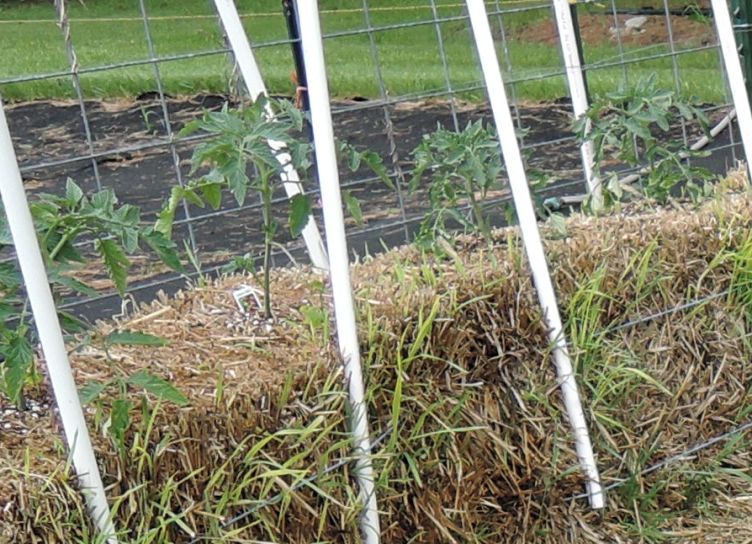
No Compost Tea Straw Bale Garden at 3 Weeks
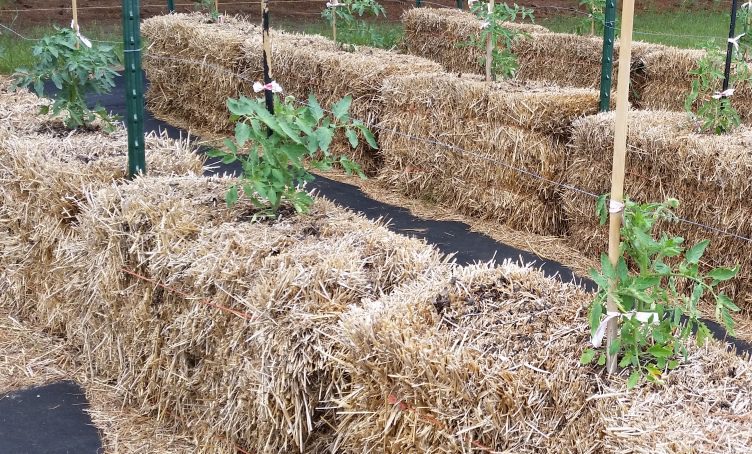
Straw Bale Garden with Compost Tea at 3 Weeks
Wondering what the white pipes are for in that first image? They hold the frost cover away from the plants. Late frost is highly possible here – even after the frost free date.
No fertilizer other than what was in the potting mix, and a little Happy Frog all purpose fertilizer has been applied to either year’s garden at this point. In 2015, I used Ocean Forest. The hydro shop was sold out, so I used Happy Frog instead in 2016. I highly doubt the difference in growth has anything to do with that, and the starters were much nicer plants last year! These tomatoes this summer started off with pitiful, anemic babies.
So, the first fertilizer application and compost tea went into my current straw bale garden the same day I took the photo above. One week later? Here’s June 29th:

Compost Tea Straw Bale Garden at Week 4
What wondrous stuff did I use for fertilizing? An all natural, all purpose liquid fertilizer made by Whitney Farms. Then I switched to Espoma Organic Bloom on everything but the herbs after mid June. The compost tea with microbes has a lot to do with the impressive growth in just one week’s time. But fertilizer is applied every two weeks, and the compost tea once a month diluted at 1:4. Tea and fertilizer were done in a single application at tea time.
The peppers started pulling out of their nutrient issue after that first compost tea/fertilizer application, but nothing like the tomatoes. The peppers were much worse when purchased. A keen reminder of what drove me to start growing my own seedlings. It’s not just a matter of driving to the greenhouse’s competitor… they have none. Unless, of course, you want to pay $5 each for Bonnie Bell plants at Kmart or Home Depot.
Last year’s pepper patch on July 7th below filled with plants I grew that had a nutrient imbalance thanks to copper toxicity from using felt as wicking material.
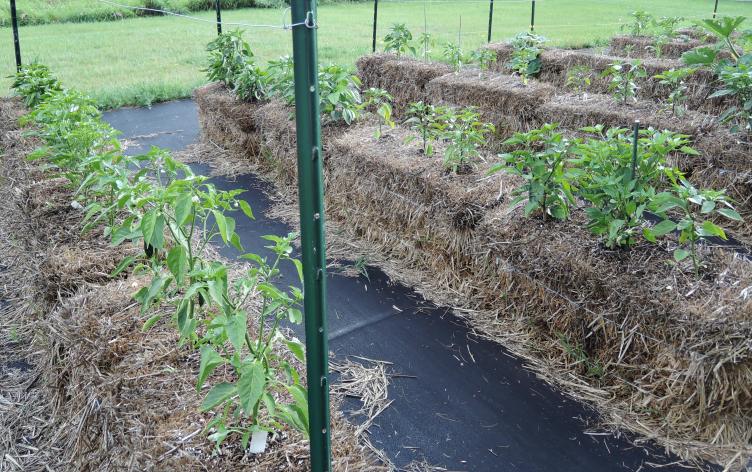
Straw Bale Garden Peppers 2015 – Early July

Straw Bale Garden Peppers 2016 – Early July
Both years they were battling issues before they ever got planted in the garden. Not sure I’m willing to try another year of peppers in straw, and not because of the nutrient problems. The Habeneros pulled out of it better than the rest from the initial purchase. I did end up paying more for some Mariachi Peppers I had to try, and the missing Serranos. The best salsas have a blend of peppers – not just Jalapenos.
In the back row of that pic from this year’s straw bale garden… Ignore the ridiculously leggy Pablanos on the left end. They were sticks when I bought them. I selected the best from the lot. In bale 2 from that end are green peppers from the same cell packs as those in bale 3 and 4. Not sure why there’s such a difference. Perhaps that bale is packed tighter than the rest and didn’t allow bone and ash penetration? They’re as sad at the end of summer as they were 6 weeks ago. I’d like to go back to getting more than 6-8 large mature bell peppers per plant.
Five days after the July tea application:
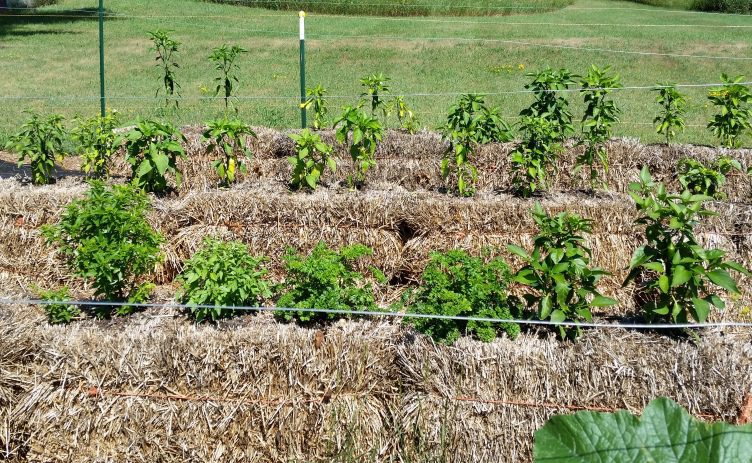
Not much increase on the peppers on July 19.

Tickled pink with the Romas’ health and vigor!
Versus last year…
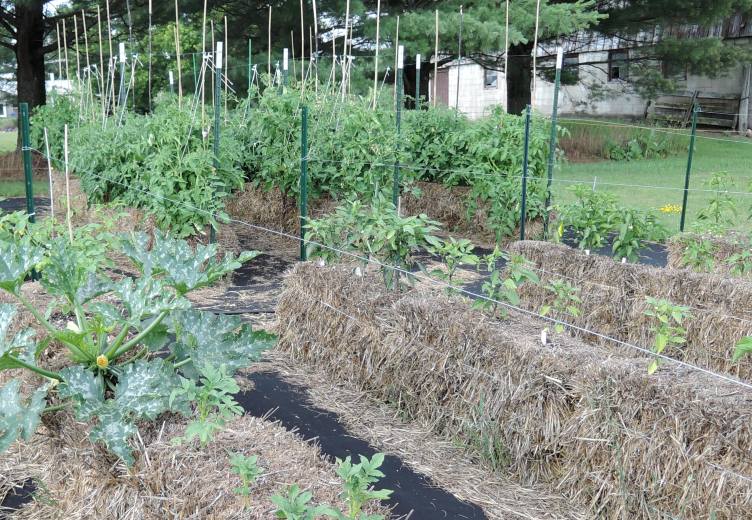
July 15, 2015
So, the larger, healthier plants that started last year’s straw bale garden that were in the bales by May 15th – aren’t any bigger by mid July. There are 2 per bale in 2015 versus 1 each for better air flow in 2016. Super important in humid climate! Last year’s fruiting plants were livin’ large on a diet of Miracle-Gro Tomato Fertilizer every 2 weeks.
Considering that I started with tomato plants only 6-10 inches tall this spring, I’d say the Espoma/compost tea regime delivers great results. Especially when I couldn’t get them planted 2 weeks ahead of the last frost date like in 2015.
Here they are on August 23rd:

Looking great and filled with fruits.
Versus the extra 2 weeks of growth in 2015:

The tomato jungle on Aug. 19, 2015.
The monsoon spell we had this August washed off all the protective Serenade coating on the tomatoes. Eight inches of water in less than 2 weeks! By the time the plants were dry enough to reapply, the fog and constant moisture had spread the spore throughout the plants. After mid-August, fog fills up that hollow and the garden many a night. After a decade of fighting this battle, I know it’s a war I will not win 🙁
There will be no tomatoes for canning again. Clearing a new spot on higher ground for next year’s garden. It will have organic straw bale tomatoes, and Evan’s compost tea, BUT…
If you’re going to do straw bale gardening – prepare to stake any plant that gets tall or has some weight to it. It will flop over. Peppers, zucchini, squash, tomatillos… in a spot with a good deal of wind, you might consider caging potatoes! The trunk and upper root zone is in a malleable media. Way different than growing in ground soil in the exact same spot. Which is the second reason I’ll not be growing some garden staples in bales from here on out. The first reason? I don’t find them to be as good of a crop – period. The plants are less full than when growing in soil, and consequently, the yield is lower too.
I will say that getting fully ripe hot peppers in early July is great, and maybe it’s worth keeping 2-3 bales for peppers in the mix just for that. Makes for a better Fresca Salsa from that first flush of ripe tomatoes. This summer is the first time I’ve ever had red Jalapenos, Habeneros, and Serranos in early August! Whether that’s because of the compost tea or the weather, I cannot say. This summer is also the first time I’ve seen dandelions in the lawn curl up and die from the lack of rain. And then we got an entire season’s worth in less than 2 weeks!
Then there are the scarred cucumbers. The straw gouges the young skin, leaving rake marks on the mature fruits. Not real impressed with the undersized Acorn squash either. I think this is from cramped roots more than fertility issues. They can’t spread out enough inside the bale’s confines.
The tomatoes are totally different. At least in my situation, where the soil stays chilly until mid to late June thanks to Spring cold, and the fickle Northern climate. I have no problem growing a great crop of anything but tomatoes year in and year out. Unless, of course, late or early frost takes out the plants. Always a possibility here.
I can reap a great harvest from tomato varieties that just don’t do well in the North, like heirlooms and Romas now. This year was the first time I’ve been able to get Romas to thrive, and they looked awesome until all that rain and fog filled them with Septoria. I have more problems with fungal issues than anyone around me thanks to that low spot out back.
If you have no soil, it’s contaminated, or inhospitable to plants – a straw bale garden is an excellent option. The complete lack of weeds is also awesome, but you can accomplish that with ground fabric like they use under pots in a nursery too. I’m switching most of what I grow in the garden to Smart Pots filled with real soil and cow manure. That’s the smart no-till way to grow a mean veggie plant, and gives more room for roots to spread out.
P.S. About those overly tight-packed bales…
The potatoes didn’t all come up in a timely fashion! And in one bale that was half hay – half straw? Only the straw side potato grew.
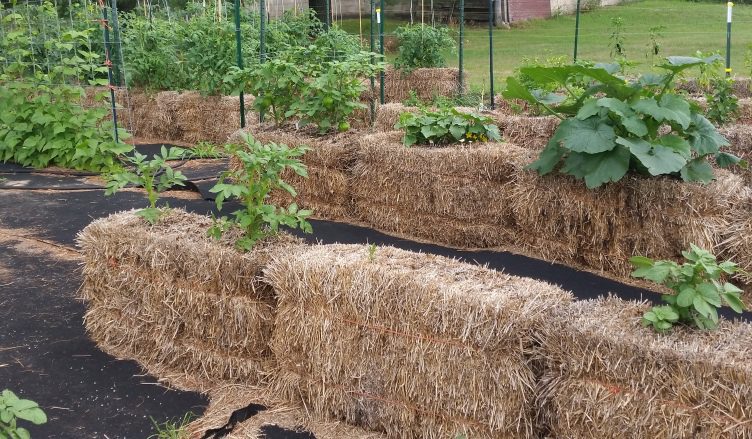
July 19 – The middle bale potatoes are just appearing!
Update…
After waving the white flag in the war against fog induced disease in August, I was pleasantly surprised to have most of the tomato harvest come through after all. The disease damage to the fruits was greatly reduced over previous years. The aerobic compost tea from Microbe Makers is most likely behind this, and it could also be due to organic inputs versus synthetic. It’s certainly not the tomato varieties I grew this year out of force, because they’ve been planted in this garden in the past, yet were more resistant than ever before. Just one more reason why it’s now a must-have part of my gardening regime.
By the time first frost was possible according to the weatherman, most of the fruits that had started forming when the blight started destroying the foliage had ripened, and at least 80% of them were in great shape for cooking and freezing. And the yield was still mighty impressive. It amazed even the neighbor I shared the glut with since the freezer is only so big. Some looked perfect enough for canning, but that’s not a good idea. You should never can tomatoes that come from a diseased plant, because it adds unseen bacteria to your jars. Chopped tomatoes frozen flat in freezer bags with most of the air pockets removed have excellent storage life. They are still good for soups, chili, and even spaghetti sauce for well over a year.